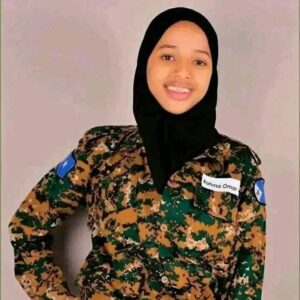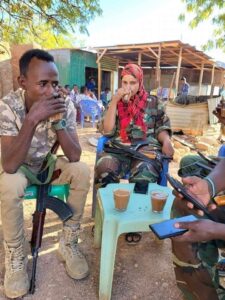(12-Feb-23) LAASCAANOOD – In the midst of the ongoing conflict in Laascaanood, a tense stand-off between the Somaliland army and local inhabitants, an unexpected yet formidable group of women has risen to prominence. Their influence is palpable both on the front lines of battle and in the digital world, where they engage a global audience.
“These women are the vanguard of a new wave of activism and resistance, both locally and internationally,” says Amina Hassan, a human rights activist in the region. “They are forcefully making the case that women should not be pushed to the periphery in matters as grave as conflict and war.”
On the front lines, these women are far from symbolic figures; they are active participants in various capacities. Whether manning checkpoints, administering first aid to the wounded, or actively partaking in combat, they aim to protect their families and homes from the incursions of the Somaliland military forces.
“No one protects your home better than you do,” observes Layla Ahmed, one of the women involved in front line duties. “We are mothers, daughters, and sisters, and we are here to shield our loved ones from harm.”
Ilham Garaad, a dentist based in the UK, is harnessing the power of social media to document the human cost of the conflict, thereby drawing international attention to the ongoing crisis. Her posts reveal the stark realities on the ground—destroyed homes, injured civilians, and the profound impact of the conflict on women and children.
“It’s not just bullets and boundaries; it’s human lives that are at stake,” Garaad states in one of her latest posts. “The world needs to understand the magnitude of suffering here. Ignorance is no longer an acceptable excuse.”
UPDATE: This video shows more than 10 military trucks of the Republic of Djibouti carrying military aid and military supplies to SNM.
This video was taken from a gas station in the Bal-Bala neighbourhood of Djibouti pic.twitter.com/bU2snROmfu
— Elham Garaad ✍︎ (@EGaraad_) February 11, 2023
Local journalist Rahma Omar, clothed in full combat uniform, made her stance clear: “We are fighting for our fundamental right to live in peace and security. The world ought to know the ground realities here, the atrocities committed, and how they affect the lives of ordinary people every single day.”
Similarly attired in her military uniform, Fahima Yusuf is taking an active role in community engagement. She has been conversing with the locals, rallying them to fight for the liberation of the people in the Sool, Sanaag, and Ceyn (SSC) regions, advocating for their independence from Somaliland secessionists.
“We can’t be passive; we need to rise and assert our freedom. The SSC regions have suffered for far too long under imposed rule,” says Yusuf, passionately urging her community to action.
 The women of Laascaanood are not merely surviving; they are thriving as a source of inspiration and resilience. Their courage and unwavering resolve in the face of adversity make a compelling case for the inclusion of women’s voices in any conflict resolution process.
The women of Laascaanood are not merely surviving; they are thriving as a source of inspiration and resilience. Their courage and unwavering resolve in the face of adversity make a compelling case for the inclusion of women’s voices in any conflict resolution process.
Dr. Halima Yusuf, a gender studies expert in the area, sums it up aptly: “Women are powerful agents for change. Their unique perspectives and courageous actions are invaluable, not just for Laascaanood but for conflict zones around the world.”
As the struggle in Laascaanood intensifies, the call for international solidarity grows ever louder. It is of paramount importance that the global community stands alongside these women, supporting their continuing fight for peace, justice, and human rights in Laascaanood and far beyond.














